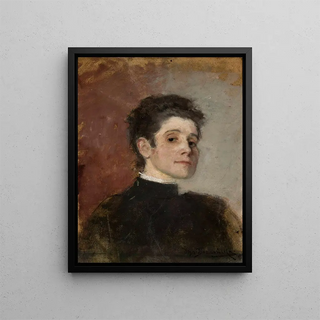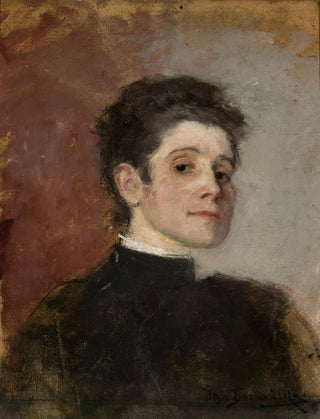Art print | Self-portrait (conflict of case) - Olga Boznańska


View from behind

Frame (optional)
Reproduction Autoportrait (conflit de cas) - Olga Boznańska – Engaging Introduction
The artwork "Autoportrait (conflit de cas)" by Olga Boznańska is a masterpiece that immerses the viewer in the intimate world of a complex and fascinating artist. Created at the end of the 19th century, this art print goes beyond merely depicting an image; it evokes a rich inner universe filled with emotions and reflections. Through her piercing gaze and contemplative expression, Boznańska invites us to share a moment of vulnerability and strength. This painting, which transcends a simple exercise in style, becomes an exploration of self, a dialogue between the artist and her audience. The soft light bathing the artist's face, along with the delicate nuances of her palette, creates an atmosphere that is both soothing and unsettling, captivating the eye and the mind.
Style and uniqueness of the work
The originality of "Autoportrait (conflit de cas)" lies in its ability to blend realism with a subtle impressionist approach. Boznańska, influenced by the great masters of her time, manages to infuse modernity into her work while respecting the codes of academic painting. The treatment of light, delicate shadows, and the texture of colors demonstrate undeniable technical mastery. Each brushstroke seems to tell a story, each shade of color evokes an emotion. What makes this art print particularly unique is the duality it embodies: an internal struggle between self-acceptance and the quest for recognition. The composition, both intimate and universal, allows the viewer to feel a deep connection with the artist, as if she were sharing her doubts and aspirations with us.
The artist and her influence
Olga Boznańska, an emblematic figure of Polish painting, left her mark on her era through her innovative approach and commitment to art. Born in Kraków in 1865, she managed to establish herself in an artistic environment dominated by men, becoming a pioneer for many women artists. Her style, which combines finesse and depth, influenced an entire generation of artists, both in

Matte finish

View from behind

Frame (optional)
Reproduction Autoportrait (conflit de cas) - Olga Boznańska – Engaging Introduction
The artwork "Autoportrait (conflit de cas)" by Olga Boznańska is a masterpiece that immerses the viewer in the intimate world of a complex and fascinating artist. Created at the end of the 19th century, this art print goes beyond merely depicting an image; it evokes a rich inner universe filled with emotions and reflections. Through her piercing gaze and contemplative expression, Boznańska invites us to share a moment of vulnerability and strength. This painting, which transcends a simple exercise in style, becomes an exploration of self, a dialogue between the artist and her audience. The soft light bathing the artist's face, along with the delicate nuances of her palette, creates an atmosphere that is both soothing and unsettling, captivating the eye and the mind.
Style and uniqueness of the work
The originality of "Autoportrait (conflit de cas)" lies in its ability to blend realism with a subtle impressionist approach. Boznańska, influenced by the great masters of her time, manages to infuse modernity into her work while respecting the codes of academic painting. The treatment of light, delicate shadows, and the texture of colors demonstrate undeniable technical mastery. Each brushstroke seems to tell a story, each shade of color evokes an emotion. What makes this art print particularly unique is the duality it embodies: an internal struggle between self-acceptance and the quest for recognition. The composition, both intimate and universal, allows the viewer to feel a deep connection with the artist, as if she were sharing her doubts and aspirations with us.
The artist and her influence
Olga Boznańska, an emblematic figure of Polish painting, left her mark on her era through her innovative approach and commitment to art. Born in Kraków in 1865, she managed to establish herself in an artistic environment dominated by men, becoming a pioneer for many women artists. Her style, which combines finesse and depth, influenced an entire generation of artists, both in






